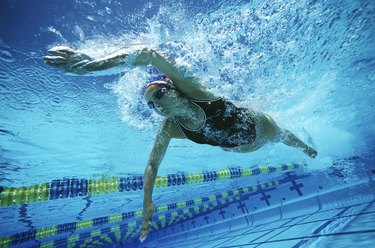
While attempting to reach 1,500 calories burned a day, it is vital to recognize the signs of extreme calorie deficits and overtraining. If you are a professional athlete, a 1,500-calorie workout might make sense for you.
Tip
A 150-pound woman would have to run at a pace of 5 miles per hour for two hours and 50 minutes to burn 1,500 calories.
Video of the Day
Know Safe Calorie Deficit Levels
Harvard Health Publishing recommends losing a maximum of 1 to 2 pounds per week, with your food consumption level at 500 to 1,000 calories less than your weight maintenance calories. This means that you shouldn't create a calorie deficit greater than 500 to 1,000 calories each day.
Video of the Day
There is one caveat; calorie intake for a woman should never be less than 1,200 calories in a day or 1,500 calories for men unless you obtain the proper supervision of a licensed health professional.
Several types of calculators can help you determine your maintenance calories. The one provided by the American Council on Exercise (ACE) allows you to include your activity level, as well as your age, weight, sex and height.
Using this calculator, you can determine your estimated daily caloric need. After that, you can subtract the number of calories required for weight loss at a safe level. For the example of a 35-year-old woman weighing 150 pounds at 5 feet, 7 inches tall, who is moderately active three to five days per week, she is estimated to need 2,432 calories per day to maintain her weight.
If she would like to lose weight, she may subtract 500 to 1,000 calories from this number. Subtracting 500 calories would mean consuming 1,932 calories per day.
Eating below these levels can cause health risks due to a lack of nutrients. If you are eating at the lowest levels of recommended calories, then you need to be extra careful about the foods that you choose. There is much less room for non-nutritive foods when you are eating less.
Be Conscious of Calories Burned
Similarly, when you create a large calorie deficit through exercise, it is essential to fuel yourself properly for your recovery and to maintain energy levels. The American Heart Association recommends always fueling up before your workout.
Otherwise, you may not have the energy to get the most out of your workout. They suggest eating healthy whole-grain carbohydrates, low-fat dairy products and fruits and vegetables, as well as avoiding saturated fat.
During your workout, especially if you are an athlete who trains for several hours at a time, it is essential also to stay hydrated. You may also need to add some intra-workout nutrition in the form of a carbohydrate or protein shake.
After your workout, be sure to refuel with plenty of fluids, including water or juice, which provide carbohydrates. If you are burning a lot of carbohydrates, such as in a 1,500-calorie workout, you will need to add additional carbohydrates, which are the primary fuel source for your muscles. Additionally, add lean protein to help repair the damage you have done to your muscles and to help them grow.
Beware of Overtraining
A March 2012 article published in Sports Health explains that overtraining syndrome can occur when increased loads of training are not combined with periods of rest and recovery. The signs of overtraining can include depressed mood, fatigue and hormonal changes.
Another condition called overreaching is similar but more prevalent, with up to 60 percent of athletes experiencing it, according to a September 2016 article published in Open Access Journal of Sports Medicine. Overreaching can cause a decrease in athletic performance.
According to a March 2015 article published in ACSM's Health & Fitness Journal, symptoms of overreaching include feeling drained, stiff, heavy, sore and no longer enjoying your workouts, the article's authors explain.
Without proper rest and recovery, including not fueling properly, your risks of overreaching are much higher. If these issues are not addressed, then you may experience increased signs and symptoms such as irritability, loss of appetite, a loss of menstruation, increased susceptibility to infections and illnesses and sleep disturbances, among other symptoms.
Read more: The Dangers of Working Out Too Much
What's a 1,500-Calorie Workout?
Continuing with the example of a 150-pound woman and using the activity calculator from ACE, in the case of running, she would have to run at a pace of 5 miles per hour for two hours and 50 minutes to burn 1,500 calories.
The same time frame applies to burn 1,500 calories while cross country skiing at a moderate pace. Cross-country hiking would require three hours and 40 minutes to burn 1,500 calories. A casual game of soccer would require three hours and 10 minutes, while competitive soccer will be closer to two hours and 15 minutes.
Of course, keep in mind that these activities vary greatly in the amount of effort that you would put into them. Your body composition and individual metabolism will affect these numbers. Humans are not calculators, and any calculations like this are based on the best scientific guess.
- Harvard Health Publishing: "Calorie Counting Made Easy"
- American Heart Association: "Food as Fuel Before, During and After Workouts"
- ACSM's Health & Fitness Journal: "Overreaching/Overtraining More Is Not Always Better"
- American Council on Exercise: "Daily Caloric Needs Estimator"
- Open Access Journal of Sports Medicine: "Diagnosis and Prevention of Overtraining Syndrome: An Opinion on Education Strategies"
- Sports Health: "Overtraining Syndrome"
- American Council on Exercise: "Physical Activity Calorie Counter"